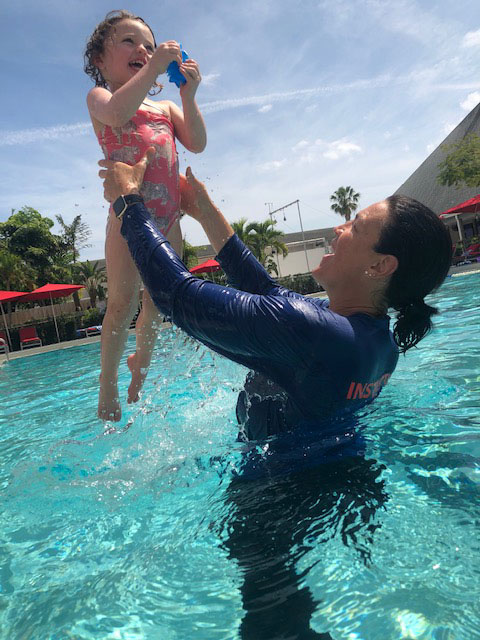How Swimming Lessons For Beginners Foster Confidence and Ability Growth
How Swimming Lessons For Beginners Foster Confidence and Ability Growth
Blog Article
Every Little Thing You Need to Learn About Swimming Lesson for Beginners: A Comprehensive Overview
Understanding the basics of swimming lessons for newbies is essential for promoting both safety and security and ability development in the water. Choosing a qualified trainer that emphasizes an encouraging discovering environment sets the phase for success. As newbies embark on this aquatic trip, understanding vital methods such as breathing and body positioning comes to be critical. Nevertheless, the path to becoming a positive swimmer is typically laden with obstacles, including the usual concern of water. What techniques can be used to guarantee a favorable and improving experience for those simply beginning?
Relevance of Water Security
Water safety is extremely important for any person venturing right into water settings, especially newbies. Recognizing the prospective threats associated with water tasks is vital to ensure a risk-free and satisfying experience. Statistics indicate that drowning remains a leading cause of unintentional fatality, emphasizing the demand for enhanced recognition and preventive measures.
The very first step in water safety entails acknowledging the value of guidance. Grownups must always maintain a close eye on youngsters and inexperienced swimmers, as also superficial water can posture significant dangers. In addition, wearing ideal flotation gadgets, such as life coats, is vital, especially for those who are not yet confident in their swimming capacities.
One more crucial facet is acquainting oneself with the specific atmosphere. Each body of water has one-of-a-kind qualities, consisting of currents, tides, and temperature level, which can impact safety and security. Swimmers must also be conscious of climate condition and possible risks, such as submerged items or abrupt changes detailed.
Locating the Right Instructor
Choosing a qualified instructor is a crucial step in making sure a reliable and safe discovering experience for newbies. When looking for an instructor, consider their accreditations and experience. Seek people who are certified in mouth-to-mouth resuscitation and Emergency Treatment, along with those who hold acknowledged swimming teaching credentials, such as those from the American Red Cross or YMCA.

Furthermore, evaluate the instructor's interaction skills. They need to have the ability to share guidelines plainly and demonstrate techniques effectively. A connection in between the teacher and the learner can boost inspiration and promote a positive understanding environment.
Lastly, take into consideration logistics such as course organizing, area, and size. Smaller sized course sizes often enable more customized interest, which can be advantageous for novices. By meticulously assessing these elements, you can locate an instructor who will add to a successful swimming experience.
Essential Swimming Strategies
Understanding vital swimming methods is vital for newbies aiming to develop confidence and proficiency in the water. The structure of efficient swimming hinges on understanding the standard skills that boost both safety and security and enjoyment during practice.
One of the first techniques navigate to this site to concentrate on is correct breathing. Beginners ought to learn to exhale underwater and breathe in promptly when transforming their heads to the side, making certain a consistent rhythm that sustains endurance. Furthermore, body placing plays a vital role; swimmers should preserve a streamlined pose, keeping the body straight and level to minimize drag.

Finally, recognizing the value of buoyancy can not be ignored. Grasping floating strategies will certainly enhance convenience and security in the water. By focusing on these vital strategies, beginners can develop a solid swimming foundation, establishing them up for better success in future lessons and advanced abilities.
Various Swimming Styles
Various swimming styles exist, each offering one-of-a-kind techniques and advantages that provide to different choices and objectives. The 4 primary strokes-- freestyle, butterfly, breaststroke, and backstroke-- form the foundation of competitive swimming and entertainment practices.
Freestyle, likewise called the front crawl, is defined by a flutter kick and alternating arm activities, enabling optimal speed and efficiency. It is typically the most prominent selection for beginners as a result of its uncomplicated technique and versatility in various water settings.
Backstroke, done on the back, utilizes a comparable flutter kick however uses a windmill arm activity. This stroke enhances body positioning and promotes relaxation in the water, making it an excellent alternative for those who may really feel distressed while swimming.
Breaststroke features a frog-like kick and browse around here synchronised arm movements, advertising a slower speed that enables improved breathing control. This stroke is especially beneficial for novices as it motivates a natural rhythm.
Last but not least, the butterfly stroke, known for its difficult strategy, incorporates a dolphin kick and simultaneous arm motions. While more sophisticated, mastering it can significantly enhance general swimming effectiveness. Welcoming these varied designs can result in a well-rounded swimming experience.
Overcoming Common Obstacles
Although swimming can be a gratifying activity, newbies usually encounter various difficulties that may hinder their development and enjoyment in the water. Begin by accustoming to the water in shallow locations, and method breathing strategies outside of the water to construct self-confidence.
One more difficulty is mastering standard techniques, such as drifting and stroke technicians. Novices should focus on proper body alignment and breathing patterns. Making use of flotation protection tools can aid in creating a feeling of balance while practicing stroke basics.

Finally, locating a helpful atmosphere, whether via group lessons or one-on-one training, can substantially improve learning. Constructive responses and support are critical for conquering obstacles and promoting enhancement. By resolving these common concerns head-on, novices can grow a positive swimming experience and development at a comfy pace.
Verdict
In recap, swimming lessons for newbies include critical aspects such as security, reliable instruction, and mastery of necessary strategies. Emphasis on core abilities, including breathing and body positioning, aids in developing confidence in the water.
Understanding the principles of swimming lessons for newbies is important for cultivating both security and ability development in the water.Water security is paramount for any person venturing into water environments, specifically beginners. Arm movements must also be collaborated with the kick; beginners should find out the significance of additional hints getting to ahead and drawing via the water properly.
Although swimming can be a satisfying task, newbies typically experience different challenges that might impede their development and satisfaction in the water. Start by adjusting to the water in shallow locations, and method breathing strategies outside of the water to build self-confidence.
Report this page